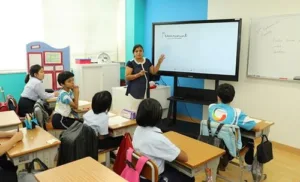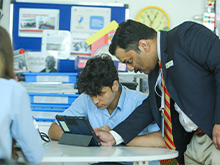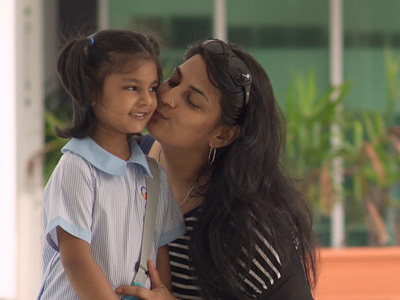Download our FREE Academic Calendar now! 📚 Start your child’s journey to success.
Learning skills is a term used to refer to tasks that help a child enhance learning which also involves improving retention. From learning how to manage and budget one’s time wisely to taking notes and reading effectively to having study skills, knowing how to take tests and more, are all learning skills.
Here are some of the ways that you could help your kids.
● Create the Right Environment
Where do your kids usually read or review for their lessons? You’ll want to create a corner where they can do all that. Do they have enough space on their desk for their books and laptop or computer? What about their folders and school supplies along with everything else that they need?
● Put a Reading Book
Reading is an essential skill, and one that’s necessary for a lot of learning activities. If you want to improve your children’s performance at their Montessori school, then put a reading book in their room. The perfect spot for reading will encourage them to open their books and dive in.
● Provide Access
Nurture your children’s curiosity and thirst for knowledge by providing them with a lot of reading materials. Making those accessible will make it easier for them to look up information about subjects that they’re interested in. It can drive them to seek further information and read more, which improves their reading skills.
● Let Them Choose
One way to get your kids engrossed in reading is to let them pick their material. If they’re already interested, then they won’t even need further urging. They’ll pick up the book and read. If you want to raise kids who love to read, then find out what their interests are. Let them pick their books and find stories that let them imagine, that resonate with them, that allow them to dream and escape reality.
● Offer Options
It’s good to train your kids to be independent. As much as you can, provide them with options. Let them choose. As kids, a lot of what they’ll do will be subject to your control. Let them be in the driver’s seat as much as you can. By giving your kids options, you recognize the value of choice and have the freedom to choose. This helps them grow independently rather than dependent on you for everything-their opinion and mindset, thoughts, beliefs, and more. It starts with choices, but by training them to think for themselves, you won’t have to worry about them growing up with no opinions of their own. Teaching them to make decisions for themselves is just the beginning. Your training will help them think for themselves too.
● Encourage Communication
Let your kids express their likes and dislikes. Create the kind of atmosphere at home that allows them to be comfortable to say what they want or not. That doesn’t mean they’ll be disrespectful, only honest and truthful about their feelings. Let them know that their opinion matters, that you listen to them, that they are free to agree or disagree with you, and you won’t judge them or put them down for an idea or belief. You won’t discourage them from sharing what they feel, nor will you ignore them.
● Teach Them to Ask for Help
Make sure your kids understand that they can come to you for anything. What if something is bothering them, they can talk to you about that. Suppose they have questions about lessons or assignments or something else, you’re there, and you should be available if they need help. If they feel the same way in class, they shouldn’t hesitate to let the teacher know. They shouldn’t feel ashamed to ask for help. Normalize this behaviour. That it’s all right to reach out and let people know you need their help.
● Focus on Their Interests
Let your kids explore the topics they love. What concepts and ideas fascinate them? Find exciting books or even games or apps about the topic and give them to your kids. Learning is so much more fun when the kids learn more about what they like, which improves their reading skills and comprehension with ease.
● Use Different Learning Styles
Kids learn at a different pace. That’s because different teaching techniques appeal to them. Some are better with visual aids, while others prefer silence. Some like talking about the topic or brainstorming ideas with a group or team, and others are more comfortable in silence. Discover what learning styles appeal to your kids by trying out a range of different ones. That way, you can identify the most effective teaching techniques that work on your kids. You can research some more on those activities, so your kids can grow up with privilege and respect.
● Share Your Enthusiasm
Good energy is contagious. If you’re smiling, and you seem pretty excited about lessons, and you ask them about their day, that’s going to make them feel good. They’ll see how enthusiastic you are, and they’ll want to be the same as you. They’ll want to radiate that same happiness and excitement. Take every opportunity to make this happen, then. Your kids will remember these moments fondly, and this can also generate positive feelings around learning and reading. That will help. When they grow up, whenever they need to learn or read or study, they might get a vague sense of being excited, content or happy, feelings that could be traced back to the time that you taught them how fun learning could be.
● Use Games
There are plenty of games that your kids can use to improve their academic performance. Some help them improve their vocabulary, and others let them practice their counting skills. By finding the right types of games-the ones that help them work on and address their weaknesses in reading or solving math problems, for instance-then your kids can benefit a lot from playing those games. There are also team-based learning games and apps. Explore those too and find out which options will work for your kids.
Boost learning skills in your kids not only for the benefit of their Montessori school grades but also for higher education.



































